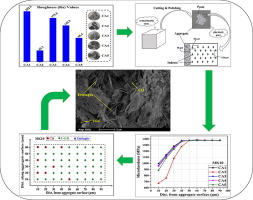Influence of the surface roughness of crushed natural aggregates on the microhardness of the interfacial transition zone of concrete with mineral admixtures and polymer latex
Abdul Qudoos, Atta-ur-Rehman, Hong Gi Kim, Jae-Suk Ryou
文献索引:10.1016/j.conbuildmat.2018.02.205
全文:HTML全文
摘要

Aggregate surface roughness has a significant effect on the interfacial transition zone of concrete. For this study, concrete specimens were prepared from five crushed natural coarse aggregates with varying surface roughnesses obtained from five different sources. The influence of polymer latex and mineral admixtures such as metakaolin, silica fume, slag, and fly ash were also studied. The effect of surface roughness on the interfacial transition zone was characterized by microhardness testing. The microhardness test results were validated via energy-dispersive X-ray spectroscopy (EDS) and scanning electron microscopy (SEM) analysis. The results showed that surface roughness has a prominent effect on microhardness of the transition zone and the effect significantly increases with the addition of cementitious materials. Polymer latex showed a slight influence on the microhardness while the effect of cementitious materials was found to be profoundly increased.
|
Corrigendum to “Assessment of test methods for characterizin...
2018-03-13 [10.1016/j.conbuildmat.2018.02.183] |
|
Identification of similar seismic events using a phase-only ...
2018-03-12 [10.1016/j.conbuildmat.2018.03.053] |
|
Deterioration mechanism of CA mortar due to simulated acid r...
2018-03-07 [10.1016/j.conbuildmat.2018.03.033] |
|
Comparison of the retarding mechanisms of sodium gluconate a...
2018-03-07 [10.1016/j.conbuildmat.2018.03.022] |
|
Effect of calcined Czech claystone on the properties of high...
2018-03-03 [10.1016/j.conbuildmat.2018.02.204] |